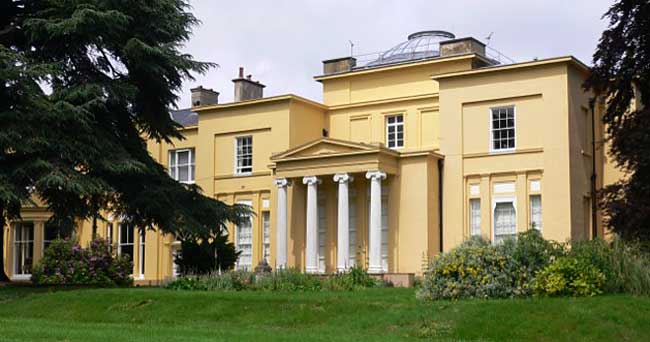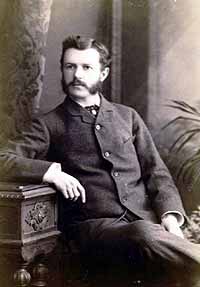
 The south front of Upton Hall.
The south front of Upton Hall.The present Upton Hall is an impressive building in the neo classical style. Pevsner writes that it is 'a stuccoed neo-Greek villa of c. 1830 by W. J. Donthorn.' There is a stone mullion window at the rear which dates from the 17th century, presumably remains of the earlier house on the site. Little is known about the original building other than it was occupied by the Oglethorpe family in the 17th century.
For the next 100 years it is not clear who lived in the house but by the time of enclosure at the end of the 18th century the land and the building were owned by Robert Smith, later Lord Carrington, the third son of Abel Smith, the owner of the Smiths Bank in Nottingham. Robert was a Member of Parliament and a staunch supporter of William Pitt the Younger who, as a reward, awarded him a baronetcy and Robert took the title of Baron Carrington of Upton.
By the end of the first quarter of the 19th century the land and the building became the property of Thomas Wright of Norwood Park, Southwell. In 1828 Thomas employed W. J. Donthorn, a founder of the Royal Institute of British Architects, to design a classical Palladian villa in a style that Thomas had seen during his travels in Italy. The house and landscaped grounds, complete with lake, bridge and classical statues were completed in 1832, not as a family home like Norwood where Thomas and his wife, Sophia, had raised their children, but as somewhere to hang the paintings and works of art collected over their lifetime. When Thomas and Sophia moved into the newly built Upton Hall, they were almost 60 and wished to live a quiet life admiring works by, among others, Titian, Van Dyck, Joshua Reynolds, Gainsborough, J.M.W. Turner, and William Etty who was a particular friend of Thomas and visited him at Upton Hall.
Thomas died on 14th January 1845, at the age of 72, eleven months after his wife and his only surviving son, the Rev. Joseph Banks Wright, inherited Upton Hall but never lived in it. Instead, it was let out to the Dowager Lady Galway of Lound Hall (near Retford) and in 1851 to Henry Hawkes, a magistrate, who was appointed as vice chairman of the Union Workhouse.
In October 1855 Joseph Banks Wright sold Upton Hall to Philip Richard Falkner, a solicitor from Newark, for the sum of £5,850, being £4,000 for the freehold and £1850 for the copyhold. Following Falkner’s death in 1888 an auction was prepared for the sale of the property, which was advertised as:
“The Estate consists of a well maintained MANSION with pleasure grounds, stables, coach houses, cow houses, piggeries and suitable outbuildings, walled kitchen garden, vinery and conservatory; also a farm house and buildings, 10 comfortable cottages and gardens, and about 64 acres of excellent arable, meadow and pasture land.”
However, a clause in his will insisted that his daughter Mary Francis Falkner, had use of Upton Hall for as long as she wished. She stayed there until about 1894, when she moved to South Leigh House in Newark’s Market Street.
 J. F. Warwick
J. F. WarwickIn April 1894 the Falkner family sold the property to John Francis Warwick, a director of the Warwick and Richardson brewery in Newark. As a young man with a young family John Francis set about re-modelling the Hall; the fireplace in the circular Grand Hall was an addition as was the frieze around the gallery depicting the hops used in brewing. An underfloor heating system was installed, and it was one of the first properties to have electricity and a telephone installed.
In 1896 Warwick built an extension which destroyed the symmetry of Thomas’ original classical building but gave us the West Wing which almost doubled the size and included a Ballroom, a billiards room and on the first floor a nursery suite and additional bedrooms. The result was as it is today, although the uses of the rooms may have changed.
In 1936, a year after the death of John Francis Warwick, Sir Albert Ball bought Upton Hall as an investment, through his company, Albert Ball (Nottm) Ltd, but he never lived in it. He had been Mayor of Nottingham in 1909, a Justice of the Peace, and the father of the World War I fighter pilot Albert Ball VC. He offered it to Mrs Leah Steer from Coventry who planned to open a school. However, the plans never came to fruition and eventually in September 1941 the company sold to the Rev. Henry Parkinson, the Rev. James Hagan, and the Rev. Thomas Finan of St. Mary’s College, Castlehead, Grange-over-Sands who intended to set up a seminary to train missionaries to work in Africa and America.
However, on 19th and 20th February 1942 a representative of the Ministry for Education, the Headmaster of Brighton Asylum for the Instruction of the Blind and the leader of Southwell Rural District Council visited Upton Hall. Mr Hughes, the Headmaster, considered it ‘almost ideal for our purposes’ consequently the Hall was requisitioned as a safe place for pupils to be evacuated during WWII to escape the German bombers.
In April 1942, 60 boys aged between 4 and 16, all with visual impairment, and three teachers arrived at Upton Hall where they spent the next three years. Some of the upstairs rooms became dormitories named Elm, Cedar and Oak and some of the downstairs ones were converted to classrooms. Outside the boys enjoyed the gardens and the apple trees in the orchard.
Only after the boys had returned to Brighton in July 1945 were the Holy Ghost Fathers from Grange-over-Sands able to take up residence. They lived a secluded existence, with vegetable gardens, beehives as well as the orchards making them as self-sufficient as possible. The Holy Ghost Fathers was a Roman Catholic order and although they mixed very little with villagers, they did enjoy competitive football games with the Anglican order based at Kelham Hall. As well as the seclusion, life was very austere for the young trainees, with very few creature comforts, but in the sale particulars in 1972 one room was a ‘television room’ although it is not clear when or by whom the television was watched.
In the early 1970s the British Horological Institute was looking to relocate from Northampton Square in London. Upton Hall appeared to be ideal with rooms that could be converted into offices, workshops for training clock and watchmakers and most importantly space for the collection of clocks, watches, books, and documents that had been donated for the use of members and students to understand the history and development of horology.
Since 1972, the BHI have continued to maintain and care for this magnificent building. The Museum of Timekeeping is home to a fascinating collection of clocks, watches, timepieces and a library that is amongst the top horological resources in the world.